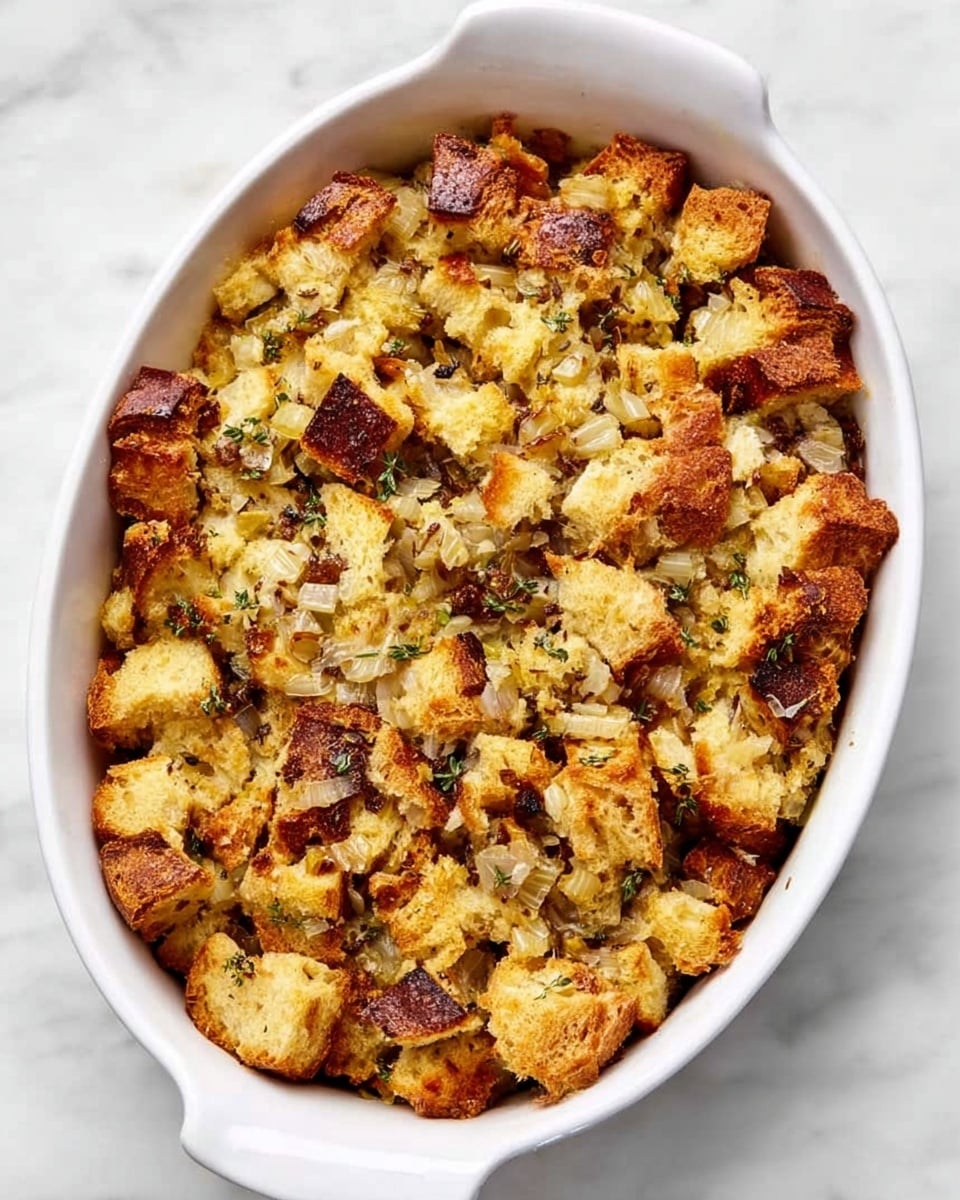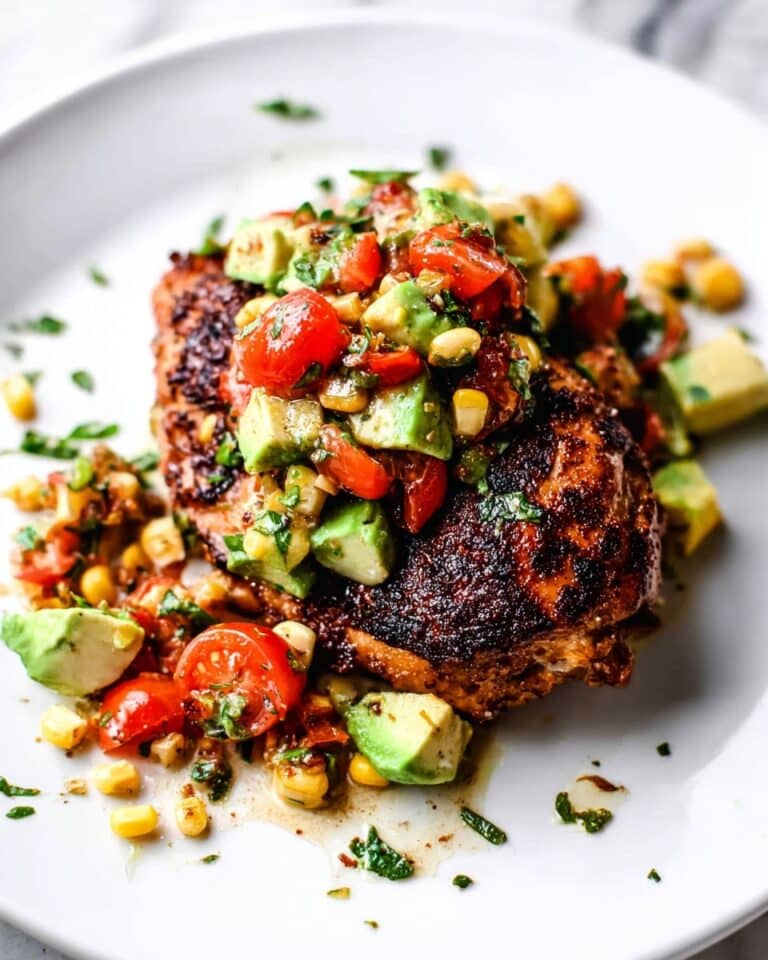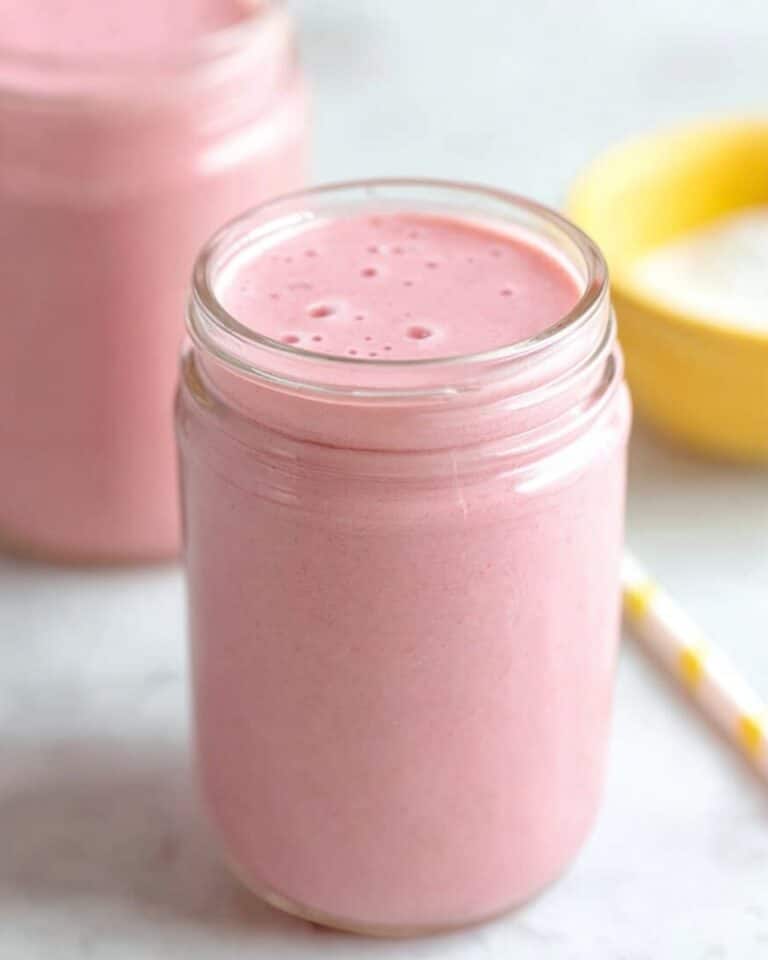I absolutely love this Classic Sage Dressing Recipe because it brings that perfect balance of comforting warmth and fresh herbaceous flavor to the table. When I first tried making it, I was amazed at how the crispy toasted bread cubes soak up the savory broth and melted butter, making every bite tender yet packed with texture. Whether it’s Thanksgiving, a family dinner, or just a cozy weekend meal, this dressing always steals the show.
You’ll find that Classic Sage Dressing is incredibly satisfying without being overly complicated. It’s one of those dishes where simple, fresh ingredients come together beautifully—with sage and thyme adding that woodsy, aromatic touch that my family cannot get enough of. Plus, it’s versatile enough to pair with turkey, chicken, or even a roast veggie spread. I’ve learned a few tricks along the way that make this recipe foolproof and super flavorful, and I can’t wait to share them with you!
Why You’ll Love This Recipe
- Easy to Make: With straightforward steps, even novice cooks can nail this classic side dish.
- Herb-Filled Flavor: Fresh sage and thyme really elevate the taste and aroma to something truly special.
- Versatile Serving: Perfect alongside poultry, pork, or vegetarian meals—always a crowd-pleaser.
- Can Be Made Ahead: Prepping it the day before means less stress on your big day.
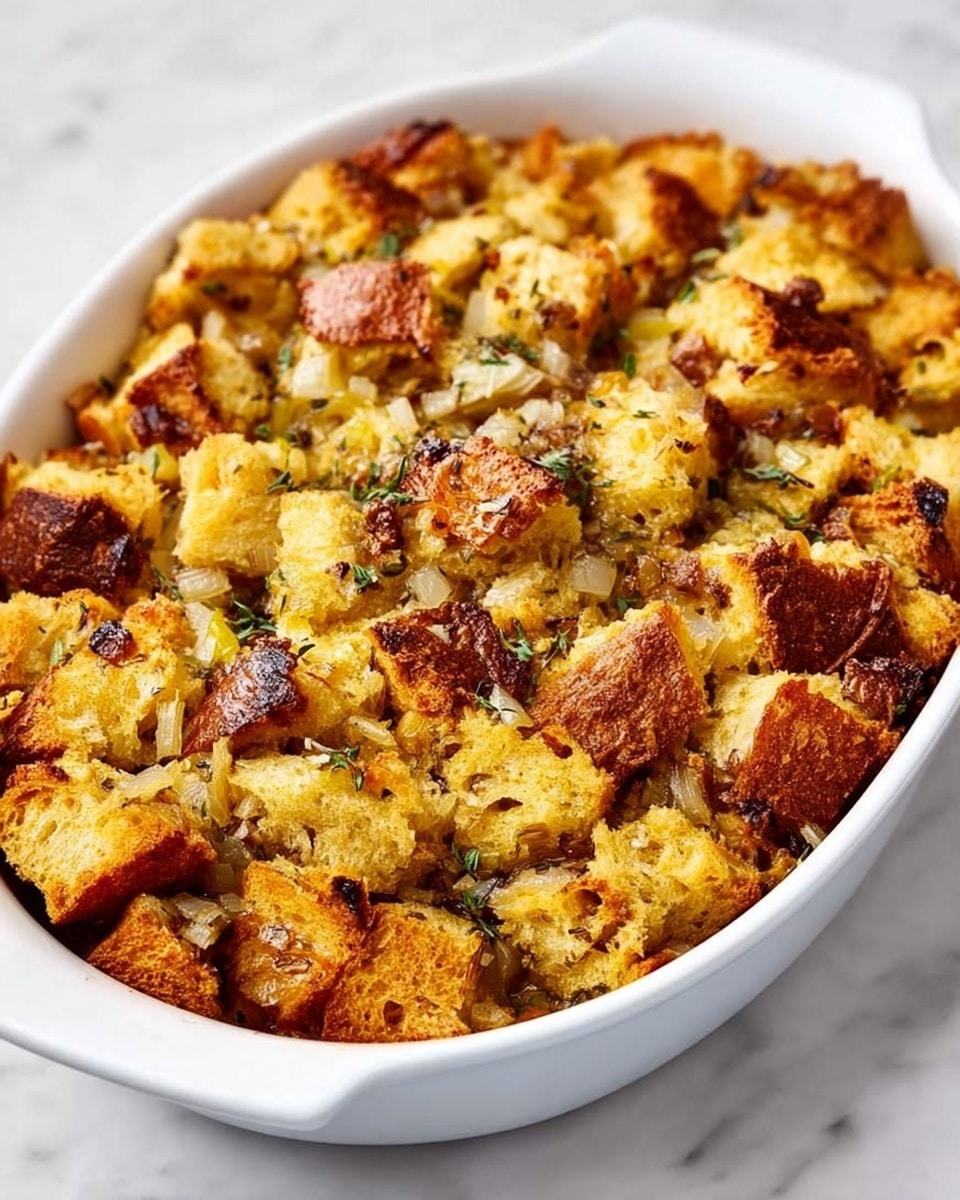
Ingredients You’ll Need
The ingredients here really come together to give you that traditional sage dressing everyone loves. I recommend using fresh herbs if you can find them—they make all the difference. Also, choose a rustic white bread for the best texture and flavor because it crisps nicely but absorbs the broth perfectly.
- Rustic white bread: Cubed and toasted for that perfect chewy and crispy texture.
- Unsalted butter: Used for cooking veggies and finishing the dish with a golden drizzle.
- Yellow onions: Adds sweetness and depth as they soften in the butter.
- Celery: Gives subtle crunch and that classic flavor base.
- Garlic: Fresh minced garlic provides a punch of warmth.
- Fresh sage leaves: The star herb—earthy, slightly peppery, aromatic.
- Fresh thyme sprigs: Adds an extra layer of fragrance alongside sage.
- Low-sodium broth: Turkey, chicken, or vegetable broth keeps it moist and flavorful without overpowering.
- Large eggs: Bind the dressing together for a perfect consistency.
- Kosher salt: Essential for seasoning and enhancing all the flavors.
- Freshly ground black pepper: Adds warm spice and balance.
Note: Exact ingredients and measurements are listed in the recipe card below.
Variations
I love customizing this Classic Sage Dressing Recipe depending on the occasion or what’s on hand. Don’t be shy about tailoring the herbs or adding a few personal touches—it’s easy to make it your own and still keep that classic soul.
- Gluten-Free Version: Swap the rustic white bread for a gluten-free loaf, toasted the same way. I did this once for a friend and nobody felt like they were missing out!
- Sauteed Mushrooms: I sometimes add mushrooms along with the onions for an earthy twist that pairs beautifully with sage.
- Vegetarian Broth: Using vegetable broth instead of turkey or chicken keeps it vegetarian without sacrificing flavor.
- Extra Herbs: You can add rosemary or parsley for a fresh pop. Just adjust the quantities so sage still shines.
How to Make Classic Sage Dressing Recipe
Step 1: Toast Your Bread Cubes Slowly
Arrange your oven rack in the middle and preheat to 225°F. Spread the bread cubes evenly on a large rimmed baking sheet and toast them gently—stir every 30 minutes to ensure even crisping. This low-and-slow method gives you the best texture: crunchy enough to resist becoming mushy but still able to soak up moisture when combined. This step takes about 90 minutes, so plan accordingly.
Step 2: Sauté the Veggies and Herbs
While the bread is toasting, melt 4 tablespoons of butter in a large skillet over medium-high heat. Toss in diced onions, celery, and garlic, cooking until everything is soft and fragrant—about 10 minutes. Then add fresh sage and thyme leaves, cooking for another 2 minutes to release their aroma. This is the flavor foundation of your dressing, so don’t rush it!
Step 3: Mix and Combine
In a medium bowl, whisk together the broth, eggs, salt, and plenty of freshly ground pepper. Once your bread cubes are ready and veggies have cooled slightly, combine them all in a large bowl. Drizzle the egg and broth mix over the bread-vegetable blend and gently fold until the cubes are evenly moistened but not mushy. Transferring it into your greased baking dish, spread it evenly and drizzle the remaining 2 tablespoons of melted butter on top. Cover tightly with foil.
Step 4: Bake It Off
Preheat your oven to 375°F and place the covered dressing in the middle rack. Bake for 25 minutes covered, then uncover and continue baking until the top gets a lovely golden brown—about 15 minutes more. If baking straight from the fridge, add 10 extra minutes to the total time. I love letting it rest for 10 minutes before serving to let the flavors settle perfectly.
Pro Tips for Making Classic Sage Dressing Recipe
- Use Day-Old Bread: I find that toasted day-old bread cubes absorb broth better without becoming too mushy.
- Don’t Skip Toasting: Toasting the bread slowly ensures a perfect texture; skip this and your dressing could turn soggy.
- Fresh Herbs Are Essential: Fresh sage and thyme give the dressing a vibrancy that dried herbs just can’t match.
- Cover While Baking: Covering the dish initially traps moisture and prevents drying out—uncover only at the end for that golden top.
How to Serve Classic Sage Dressing Recipe
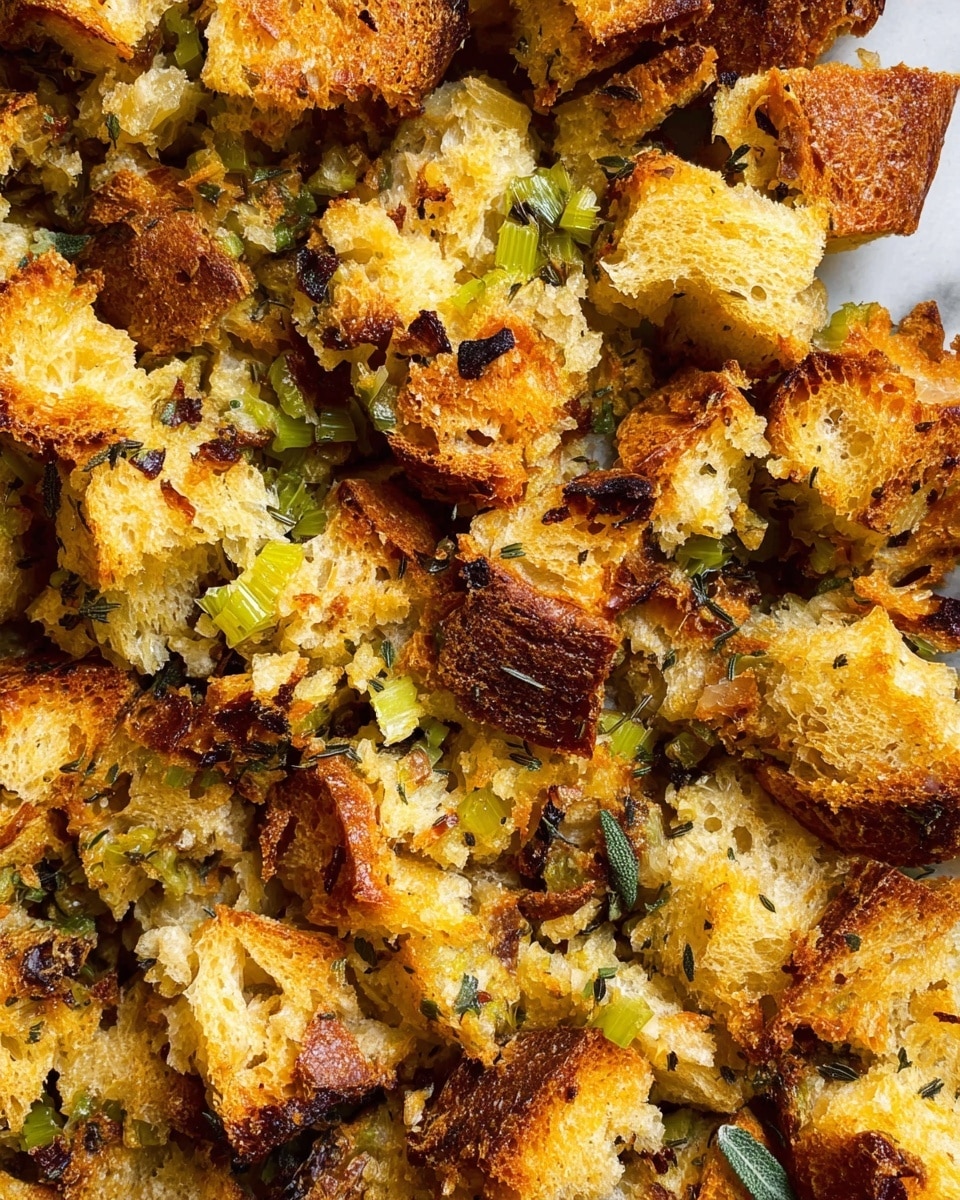
Garnishes
I like to sprinkle a little extra chopped fresh sage or even a few crispy fried sage leaves on top for a stunning, fragrant finish. Sometimes, a light drizzle of melted butter right before serving adds a glossy touch that makes it even more inviting.
Side Dishes
This dressing pairs beautifully with roasted turkey, glazed ham, or baked chicken. I especially enjoy it alongside roasted root vegetables or a bright cranberry sauce to balance all the savory notes. It’s truly a star when served with classic holiday mains.
Creative Ways to Present
For holiday dinners, I arrange the dressing in individual ramekins topped with a sage sprig—makes for an adorable personal serving. Another fun idea I tried was baking the dressing inside hollowed-out mini pumpkins or squash for a festive autumn flair that impresses guests every time.
Make Ahead and Storage
Storing Leftovers
Leftover dressing keeps wonderfully in an airtight container in the fridge for up to 3 days. When I store it, I like to press a layer of plastic wrap directly onto the surface before sealing to keep it from drying out.
Freezing
I’ve frozen classic sage dressing a couple times by placing it in a freezer-safe dish, tightly wrapped. It holds up well for about 2 months. Thaw it overnight in the fridge before baking it again, and it tastes just as comforting as freshly made.
Reheating
To reheat, I cover the dressing with foil and warm it in a 350°F oven for about 20 minutes or until heated through. This helps keep the top from drying out and retains that fresh-baked flavor and texture.
FAQs
-
Can I use dried sage instead of fresh for this Classic Sage Dressing Recipe?
While dried sage can be used in a pinch, it won’t provide the same vibrant flavor and aroma as fresh sage. If you do use dried, reduce the amount by about half, as dried herbs are more concentrated. For the best results and authentic taste, fresh is definitely worth the extra effort.
-
How do I make this dressing gluten-free?
Simply substitute the rustic white bread with your favorite gluten-free bread, toasted the same way. Make sure your broth and other ingredients are also gluten-free to keep everything safe and delicious.
-
Can I prepare the Classic Sage Dressing Recipe the day before serving?
Yes! You can assemble the dressing and refrigerate it covered overnight or up to 24 hours before baking. Just be sure to add a little extra baking time if it goes into the oven straight from the fridge.
-
What type of broth is best for this dressing?
Low-sodium turkey, chicken, or vegetable broth all work well. Choose based on your main dish and dietary preferences. I tend to use turkey broth when serving this with roast turkey—it enhances the overall harmony of flavors.
Final Thoughts
This Classic Sage Dressing Recipe is one of those beloved dishes that always makes me feel right at home in the kitchen. It’s tried, true, and loved by my family year after year, and I truly believe it can bring that same comforting touch to your dinner table too. Give it a try, trust the process, and soon you’ll have a go-to side that feels both traditional and fresh—just like a warm hug on a chilly day.
PrintClassic Sage Dressing Recipe
A classic sage dressing recipe featuring rustic white bread toasted to perfection, sautéed onions, celery, garlic, and fresh herbs, combined with broth and eggs for a moist, flavorful side dish ideal for holiday meals or comforting dinners.
- Prep Time: 25 minutes
- Cook Time: 1 hour 45 minutes
- Total Time: 2 hours 10 minutes
- Yield: 6 to 8 servings
- Category: Side Dish
- Method: Baking
- Cuisine: American
- Diet: Halal
Ingredients
Bread
- 1 (16- to 18-ounce) loaf rustic white bread, cut into 1-inch cubes (about 10 cups)
Vegetables and Herbs
- 1 pound yellow onions, diced
- 4 large stalks celery, diced
- 4 cloves garlic, minced
- 1/4 cup finely chopped fresh sage leaves
- Leaves from 4 fresh thyme sprigs
Dairy and Binding
- 4 tablespoons unsalted butter, plus an additional 2 tablespoons melted
- 2 large eggs
Liquids and Seasoning
- 2 cups low-sodium turkey, chicken, or vegetable broth
- 1/2 teaspoon kosher salt
- Freshly ground black pepper, to taste
Instructions
- Toast Bread Cubes: Arrange a rack in the middle of the oven and preheat to 225°F. Spread 10 cups of bread cubes on a large rimmed baking sheet and bake until they are quite crisp, stirring every 30 minutes, about 90 minutes total. This step ensures your bread is perfectly dried out for the dressing.
- Sauté Vegetables and Herbs: Lightly grease a 9×13-inch or 3-quart baking dish and set aside. Melt 4 tablespoons of unsalted butter in a large skillet over medium-high heat. Add the diced onions, celery, and minced garlic, cooking while stirring frequently until the vegetables are very soft, approximately 10 minutes. Stir in the finely chopped sage leaves and thyme sprigs, cooking for 2 more minutes before removing from heat.
- Mix Wet Ingredients: In a medium bowl, whisk together 2 cups of low-sodium broth, 2 large eggs, 1/2 teaspoon kosher salt, and a generous amount of freshly ground black pepper. Set this mixture aside as it will moisten the dressing.
- Combine Bread and Vegetables: Transfer the toasted bread cubes and sautéed vegetable-herb mixture into a large bowl and fold gently to combine evenly.
- Add Egg Mixture and Butter: Drizzle the egg and broth mixture into the bowl with the bread and vegetables, folding until everything is evenly moistened. Transfer this mixture to the prepared baking dish, spreading it into an even layer. Drizzle the remaining 2 tablespoons of melted butter over the top. Cover tightly with aluminum foil. At this point, you may refrigerate the dressing overnight or for up to 24 hours.
- Bake the Dressing: When ready to serve, preheat the oven to 375°F with a rack in the middle. Bake the covered dressing for 25 minutes. Then remove the foil and continue baking uncovered until the top is lightly browned, about 15 minutes more. If baking directly from the refrigerator, add an extra 10 minutes to the bake time.
- Rest before Serving: Let the dressing stand for 10 minutes after baking to set properly and enhance flavors before serving.
Notes
- You can use low-sodium chicken, turkey, or vegetable broth depending on your preference or dietary needs.
- For best texture, make sure the bread cubes are thoroughly toasted and crisp before mixing.
- The dressing can be prepared a day ahead and kept refrigerated, making it convenient for holiday meal prep.
- Use fresh herbs for optimal flavor; dried herbs can be substituted but reduce quantity as they are more concentrated.
- If you prefer a gluten-free option, substitute the rustic white bread with gluten-free bread cubes.

